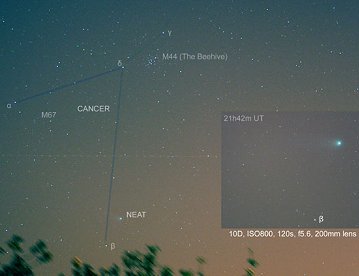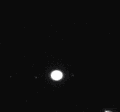 Would you like a call when the space station flys over your home town? Sign up for Spaceweather PHONE.
Would you like a call when the space station flys over your home town? Sign up for Spaceweather PHONE.
SUNSPOT WATCH: Yesterday, sunspot group 609 was practically invisible; today it's wider than Earth and visible from a distance of 93 million miles. See for yourself--but never stare at the sun. Always practice safe solar observing techniques.

This 48-hour animation (credit: SOHO) shows how quickly sunspot 609 grew on May 12th and 13th. Individual spots within the group are about the size of Earth. The region's fast-changing magnetic field poses a threat for M-class solar flares.
COMET NEAT & THE BEEHIVE: Tonight, Comet NEAT (C/2001 Q4) glides by the Beehive star cluster (M44) in Cancer. To the unaided eye, the Beehive looks like a faint nebula; through binoculars or a small telescope, it reveals itself to be a sparkling cluster of hundreds of stars. Look for the pair in the western sky about 30 minutes after sunset. Binoculars are recommended. [sky maps: the big picture, the details]

Above: Comet NEAT approaches the Beehive Cluster on May 12th. Credit: Pete Lawrence of Selsey, West Sussex, UK. Click on the image for camera settings and other details.
more images: from Jack Newton of Arizona (2-min. exposure, May 12); from Terry Lutz of light-polluted Plymouth, Ohio (2-min. exp., May 12); from George Normandin of Vestal, New York (May 11); from Choongsoo Shin of Stanford, California (May 12); from Tim Printy of Hillsborough, New Hampshire (May 11); from Philippe Moussette of St-Elzéar, Québec, Canada (May 9).
 THE ISS & JUPITER: The International Space Station (ISS) eclipsed Jupiter on May 13th. George Varros of Maryland recorded the event ... almost. "I missed the total eclipse," says Varros, "because I was a few hundred meters east of the ground track." The path of totality was only 80-meters wide, so it was easy to miss. Nevertheless, Varros did capture this video of the space station 40 arcseconds from the giant planet.
THE ISS & JUPITER: The International Space Station (ISS) eclipsed Jupiter on May 13th. George Varros of Maryland recorded the event ... almost. "I missed the total eclipse," says Varros, "because I was a few hundred meters east of the ground track." The path of totality was only 80-meters wide, so it was easy to miss. Nevertheless, Varros did capture this video of the space station 40 arcseconds from the giant planet.
CRESCENT VENUS: If you have a telescope, even a small one, point it at Venus. The planet, which has phases like the Moon, looks like a slender silvery crescent. Beautiful! You can find Venus shining brightly in the western sky at sunset. Venus is nearing Earth, so the crescent will grow larger and thinner every night for the rest of this month.

